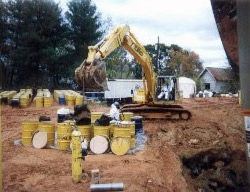Land and Waste: Hazardous Waste
- Permits active treatment, storage and disposal facilities
- Guides cl
 ean-up actions for thousands of waste management units
ean-up actions for thousands of waste management units - Provides regulatory concurrence to the regulated community and their consultants in Hazardous Waste Management
- Develops South Carolina's Hazardous Waste Management Regulations and seeks authorization from EPA for the State prog
Groundwater Use and Reporting - Laws and Regulations
The Groundwater Use And Reporting Act
(Chapter 5 of Title 49, Section 49-5-10 et. seq. of the 1976 Code as amended)
Regulation 61-113, Groundwater Use and Reporting
South Carolina Surface Water Withdrawal and Reporting Act
(Chapter 4 of Title 49, Section 49-4-10 et. seq. of the 1976 Code as amended)
Groundwater Use - Permitting Info
- Groundwater Withdrawal Permit Application and Directions (PDF-191 KB)
- Water Use Registration (PDF-86 KB)
- Monitoring Well Application (PDF-87KB)
Surface Water
Groundwater Capacity Use Areas - Santee-Lynches
SCDES is permitting the Santee-Lynches Capacity Use Area. Applications can be found below.
Groundwater Withdrawal Permitting & Capacity Use Areas
Six areas within the state have been designated as Capacity Use Areas (see Figure 1). These include the Low Country (Beaufort, Colleton, Hampton, and Jasper counties), the Pee Dee (Darlington, Dillon, Florence, Marion, Marlboro, and Williamsburg counties), the Trident (Berkeley, Charleston, and Dorchester counties), the Waccamaw (Georgetown and Horry counties), the Western (Aiken, Allendale, Bamberg, Barnwell, Calhoun, Lexington, and Orangeburg counties), and the Santee-Lynches (portions of Chesterfield, Kershaw, and Richland counties, along with Clarendon, Lee, and Sumter counties).
Groundwater Process and Plan Development
Effective management of our groundwater resource ensures:
Groundwater Capacity Use Areas - Western South Carolina
The Western Capacity Use Area
On November 8, 2018, the South Carolina Department of Health and Environmental Control Board, as established in Section 49-5-60, approved the designation of all of Aiken, Allendale, Bamberg, Barnwell, Calhoun, Lexington and Orangeburg Counties as the Western Capacity Use Area.

